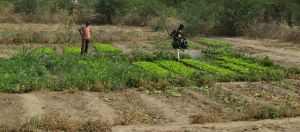Protecting the Climate with Biomethane in Togo and Ghana
What sort of potential does biogas have in the African countries of Togo and Ghana? Researchers for the German Biomass Research Center (DBFZ) have been trying to answer that question. They have now presented their results in a feasibility study.
The biomethane obtained and then treated in biogas plants can, for example, replace charcoal and fossil fuels (e.g. natural gas, petrol, and diesel) in Togo and Ghana. Less forest would then be cleared for charcoal and less CO2 be released into the atmosphere. This would protect the climate and mean improved air quality, particularly in cities. Furthermore, establishing more efficient recycling pathways for organic waste, such as cassava peel, can lead to a higher electrification rate.
In Togo, a total of 23 raw materials that are available for biomethane production were examined. With them, 50 million environmentally friendly gas cylinders of 15 kilogrammes each could be made available and used as fuel for transport, for instance. Alternatively, the biogas produced could be used to replace around 1.3 million tonnes of charcoal. If just a quarter of the full potential were used, up to 8,500 ha of woodland could be saved from possible deforestation and prevented from then being processed further into charcoal. The five primary raw materials cover more than half of the overall potential. These are maize stalks, food waste, solid cow dung, sorghum straw, and yam straw.
In Ghana, the potential for biomethane production is even greater. Here, using 22 possible biogenic raw materials, as many as 220 million environmentally friendly gas cylinders of 15 kilogrammes each could be made available, or 5.8 million tonnes of charcoal could be replaced. The five primary raw materials here also cover more than half of the overall potential. These are cassava peel, yam straw, food waste, maize straw, and solid cow dung. However, the researchers note that the mobilization of the relevant raw materials for the production of biomethane depends on a whole range of regional conditions. If just a quarter of Ghana's biomass potential is used, up to 37,500 ha of woodland can be protected from deforestation.

The technology screening shows that in Togo, maize stalks are the dominant residue with the highest calorific value. However, substrate blends (e.g. food waste and/or animal excrement) are necessary to offset the adverse raw material properties for biomethane production. The situation in Ghana is similar. Cassava peel is the residue with the highest calorific value, but the adverse raw material properties for the biogas process, like the high dry matter content, must be offset with substrate blends (e.g. residue like plantains, food waste and/or animal excrement). The technical complexity and investment costs of fermentation plants can be adapted as needed to usage requirements and factors related to the location (e.g. for rural areas or for industrial/urban application).

The experts recommend that the next step be to identify potential regional constraints that limit the use of biomass for a fermentation process. Furthermore, existing uses (e.g. as animal feed or fertilizer) for selected biomasses should be determined so as to safeguard existing nutrient cycles.
The researchers advise identifying mobilizable potential of other biomasses (e.g. existing collection systems for food waste and the availability of animal excrement depending on the farming methods) and including other promising biomasses in the resource screening (e.g. sewage sludge and industrial residue in fruit processing). It is necessary to clarify infrastructural (e.g. power grid, roads) and social (e.g. acceptance) factors. The question then remains of what recycled product (gas cylinder, cooking gas, electricity, etc.) the biogas/biomethane is to be put towards and where a biogas plant could be built.
Local partners and stakeholders must be included and existing knowledge consolidated in order for the recommended next steps to be implemented.




